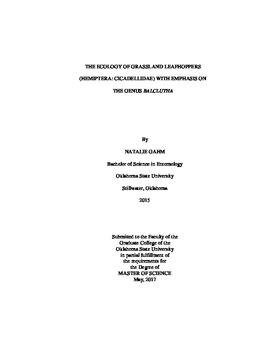| dc.description.abstract | Leafhoppers (Hemiptera: Cicadellidae) inhabit a broad range of ecological niches, including grassland ecosystems. These insects feed on vascular tissues and many species are economically important vectors of plant pathogens. The invasive red streaked leafhopper, Balclutha rubrostriata (Melichar), was first documented in Texas on King Ranch bluestem, Bothriochloa ischaemum, and has since been found in Louisiana and Oklahoma. As part of an effort to document range expansion of B. rubrostriata and the seasonal abundance of key vector species, optimal time of day for leafhopper sampling, leafhopper assemblages on mixed grasses with and without dominant B. ischaemum, and seasonal presence/absence of B. rubrostriata on B. ischaemum was determined. After repeated observations of Balclutha leafhoppers on seed heads, preference of the B. rubrostriata congener, B. neglecta, for specific B. ischaemum tissues was also tested. Sweep samples were collected at morning, midday, and evening at the Oklahoma State Botanic Garden to study sampling efficiency, and weekly sweep samples were collected from grass patches throughout Payne County, with the captured leafhoppers identified to genus. The presence or absence of B. rubrostriata in central Oklahoma was monitored, and B. ischaemum tissues were stained to quantify salivary sheaths left by B. neglecta and Exitianus exitiosus. More leafhoppers were captured during midday, but insignificantly so. Furthermore, leafhopper populations fluctuated diurnally and seasonally and this varied by species. Leafhoppers were more abundant in mixed grasses without dominant B. ischaemum, but there were no significant differences in richness or diversity. Key vector species that were consistently collected were E. exitiosus, Endria inimica, and Macrosteles quadrilineatus. Balclutha rubrostriata was absent during spring and summer months, but present in the adult stage throughout central Oklahoma in late fall, suggesting vegetational or migratory movement from southern regions. Finally, this study documents leafhopper probing in grass seed heads, but no specific preference for them over stem tissue by B. neglecta or E. exitiosus. The high proportion of leafhopper vectors present in multiple habitat types has potential implications for the movement of pathogens from mixed grasses to cultivated grasses. Knowing when target species are most abundant could facilitate future grassland health or crop system research. | |
